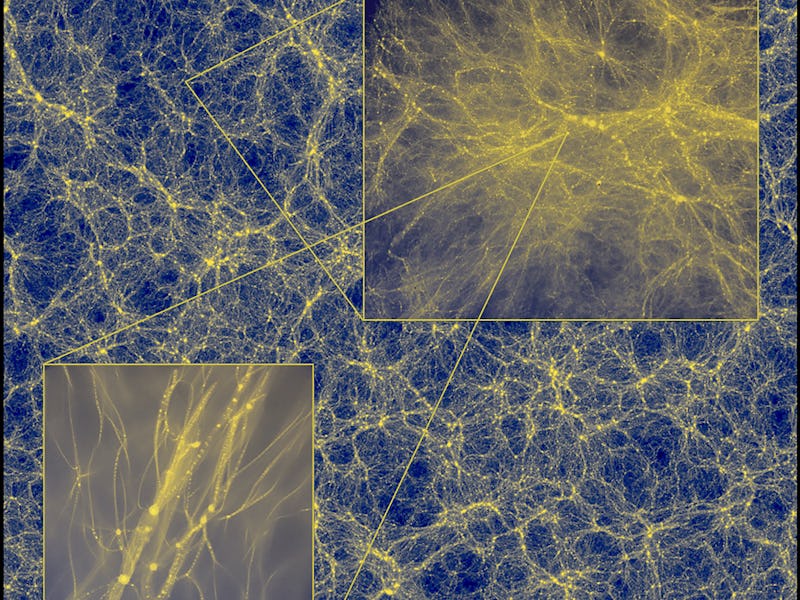Dark matter halos could help scientists find the missing force in the universe
A virtual universe could help scientists find dark matter in the real universe, a new study suggests.

Dark matter accounts for some of the universe's greatest mysteries, but as a force, it too generates a seemingly never-ending list of unanswered questions.
Scientists believe dark matter makes up around 80 percent of the universe. Yet despite this abundance, it has never been successfully detected. Its presence can only be inferred from its gravitational pull, rather than any kind of visual evidence in the cosmos.
But by building a virtual universe, scientists were able to zoom in on clumps of dark matter, known as dark matter halos in unprecedented detail. By studying these virtual bodies, scientists may be inching closer to finding this mysterious force in the real universe.
The experiment is detailed in a study published Wednesday in the journal Nature.
Dark matter was first discovered in 1933, when astronomer Fritz Zwicky noticed there was something missing from the universe. Some form of mass had to account for the space in between cosmic bodies, and hold matter in place through gravitational force.
This missing massive force was dubbed dark matter.
In one of the universe's most fundamental processes, galaxies are formed from the cooled and condensed gas at the center of enormous clumps of this dark matter, dubbed dark matter halos. The galaxies, which are visible to us, enable astronomers to infer the existence of dark matter halos, and predict some of their properties.
But these halos can't be observed using our current technology. So to capture images of the dark matter halos, the team behind the new study used supercomputers based in Europe and China to recreate an average region of the universe in virtual reality. The area of the simulated universe simulation measured 2.4 billion light years on each side.
The simulation allowed them to zoom in on the universe, at a resolution equivalent to zooming in on a flea on the surface of the Moon, according to the researchers.
As a result, they were able to see hundreds of clumps of dark matter, ranging in size from incredibly large to extremely small.
The dark matter density map, with the zoomed in square measuring 783 light years across, or 500 times the size of the Solar System.
The largest halos can contain massive galaxy clusters, or groups of hundreds of galaxies, each weighing around 1,000 trillion times more than the Sun. Because of that, it was relatively easier to figure out these halos' structures.
By contrast, not much was known about smaller halos, some of which scientists believe may be about the same mass as Earth. Their size means they are too small to contain any galaxies, and thus, harder to infer details on.
"By zooming in on these relatively tiny dark matter haloes we can calculate the amount of radiation expected to come from different sized haloes," Carlos Frenk, Ogden Professor of Fundamental Physics at the Institute for Computational Cosmology at Durham University and co-author of the new study, said in a statement.
Counterintuitively, the largest and smallest dark matter halos appear to have a very similar internal structure, and both are extremely dense in the center.
"We were really surprised by our results," Simon White, a researcher at the Max Planck Institute for Astrophysics, and co-author of the study, said in a statement.
"Everyone had guessed that the smallest clumps of dark matter would look quite different from the big ones we are more familiar with. But when we were finally able to calculate their properties, they looked just the same," he added.
By studying these smaller dark matter halos, scientists hope to apply their findings to detect real dark matter. One theory of dark matter halos is that particles of dark matter may collide with each other in the center of the halos, producing a burst of radiation. These emissions may be detectable in halos too small to contain any stars.
"Future gamma-ray observatories might be able to detect these emissions, making these small objects individually or collectively 'visible,'" Frenk said.
"This would confirm the hypothesized nature of the dark matter, which may not be entirely dark after all."
Abstract: Cosmological models in which dark matter consists of cold elementary particles predict that the dark halo population should extend to masses many orders of magnitude below those at which galaxies can form1–3 . Here we report a cosmological simulation of the formation of present-day haloes over the full range of observed halo masses (20 orders of magnitude) when dark matter is assumed to be in the form of weakly interacting massive particles of mass approximately 100 gigaelectronvolts. The simulation has a full dynamic range of 30 orders of magnitude in mass and resolves the internal structure of hundreds of Earth-mass haloes in as much detail as it does for hundreds of rich galaxy clusters. We fnd that halo density profles are universal over the entire mass range and are well described by simple two-parameter ftting formulae4,5 . Halo mass and concentration are tightly related in a way that depends on cosmology and on the nature of the dark matter. For a fxed mass, the concentration is independent of the local environment for haloes less massive than those of typical galaxies. Haloes over the mass range of 10−3 to 1011 solar masses contribute about equally (per logarithmic interval) to the luminosity produced by dark matter annihilation, which we fnd to be smaller than all previous estimates by factors ranging up to one thousand3 .